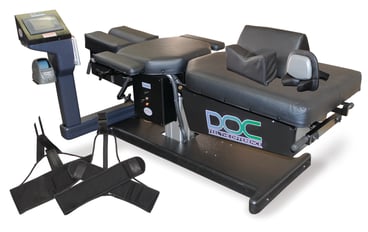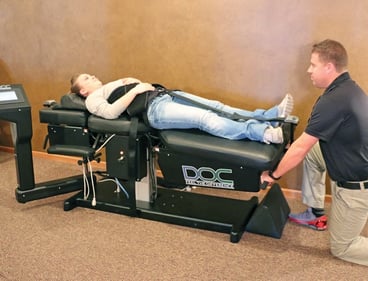In my experience, most doctors looking for a decompression table fall into two categories:
1) You are either looking for the best therapeutic table for the money or
2) The fanciest-looking table to impress your clients.
Now if you want fancy looking, there are options. Fancy-looking tables with lots of lights generally come with a pretty hefty price tag, up to five times the price to maintain and repair, and generally don’t do half of what some of the newer technologies do. Because of this, I would say most chiropractors would benefit most from the best table for their money, one that will give them the best clinical results, last the longest and have the fewest amount of repairs throughout its lifetime.
 With that said, below are six things you should consider when shopping for a decompression table:
With that said, below are six things you should consider when shopping for a decompression table:
Reliability. Just like when you’re shopping for a car, the priciest model with all the frills might look great, but it has hundreds more moving parts and more opportunity for breakdowns and repairs. When it comes to a decompression table, those repairs cost money, and also time and revenue away from patient care. A simpler table with fewer moving parts can be less expensive up front and less over time as well.
Space. Today’s clinics are looking for the most efficient use of space. People are not just downsizing their clinics but they are also looking to get as much equipment as possible in the least amount of space. From a physical space standpoint, the right table is one that’s small enough to fit in your space but strong enough to support larger patients.
Cost. What’s your budget? “Wow factor” tables with all the frills can run up to $100,000, while excellent decompression tables that are small, mobile, reliable yet tough enough to support larger patients start at $13,000 – ie the DOC Decompression table.
New or used? You may think that purchasing a fancy used table might be a good compromise. But consider this: Any decompression table typically has a 10- to 15-year lifespan. If you’re spending $15,000-$25,000 to buy an 8-year-old used high-end table, what are you really paying for? At that point in its lifespan, a decompression table might need a major overhaul in its computers, software and more. Compare that to a new table that you could buy for the same price or less and rely on for the next 10 to 15 years.
 Flexibility. Tables like the DOC decompression table work in three dimensions, a near unlimited number of patient positions including flexion, extension, lateral flexion and rotation, as opposed to one-dimensional tables that only allow you to work on patients lying on their backs with knees up. There’s no need to settle for outdated technology offering just one patient position any longer.
Flexibility. Tables like the DOC decompression table work in three dimensions, a near unlimited number of patient positions including flexion, extension, lateral flexion and rotation, as opposed to one-dimensional tables that only allow you to work on patients lying on their backs with knees up. There’s no need to settle for outdated technology offering just one patient position any longer.
Tax breaks. If you buy a decompression table before the end of the year, you may qualify for up to a $5,000 Income Tax Credit. Be sure to check with your Tax Advisor to determine if this purchase qualifies you for the Section 44 Tax Credit and the Section 179 Deduction. Talk to your tax advisor for more details.
So if you’re adding decompression to your practice or simply need to upgrade your table, consider your options. A new decompression table isn’t just an investment for today, but for the next 10 to 15 years. Take into account all the costs over your product’s lifespan, as well as the effectiveness and reliability you need for your day-to-day practice.


